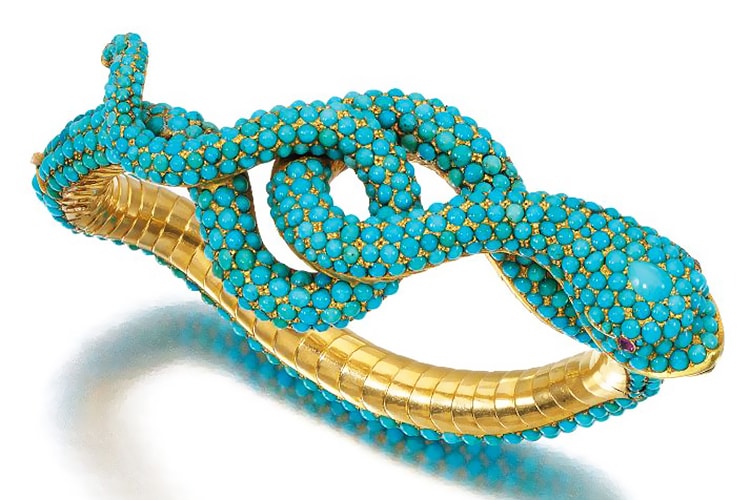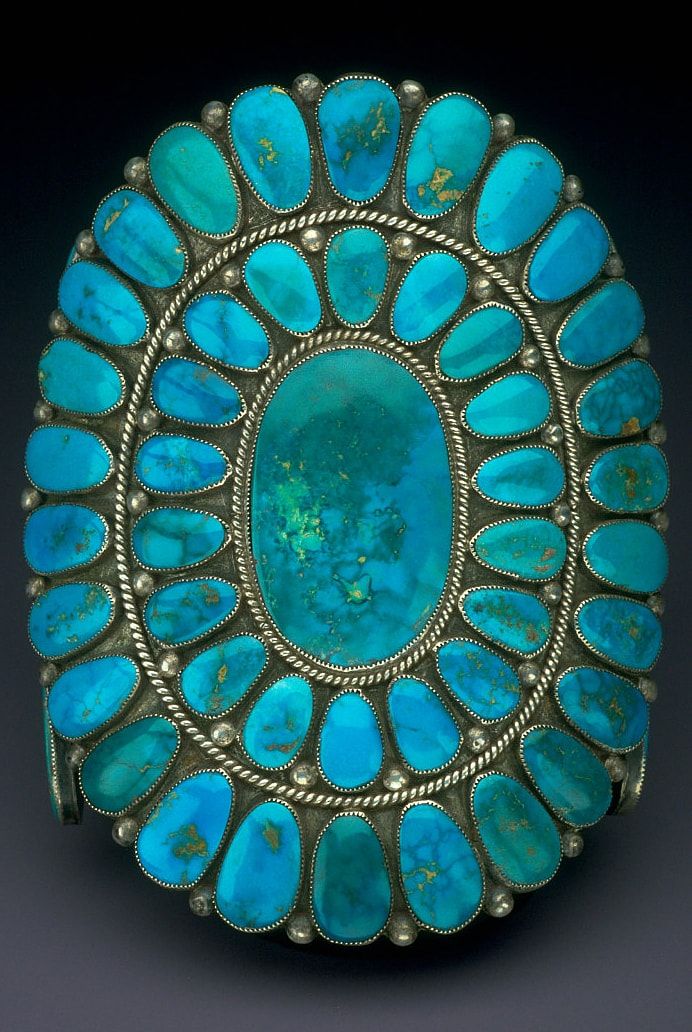Guide to Turquoise

Victorian turquoise and ruby bangle circa 1850. Source: Sotheby’s
History, Lore and Appreciation
Turquoise’s startling blue colors and soft, slightly porous texture may be the reasons why it has been such an important opaque gem for thousands of years and across so many civilizations. Excavations from Pharaoh mummies dating up to seven millennia ago contain evidence (turquoise bracelets) that the gem was highly prized in ancient Egypt – both as a gemstone and as an ornamental material. Successive Egyptian dynasties since then used also the gem as a symbol of good fortune, with historical sources in the Sinai Peninsula and in today’s Iran.
China was a source for turquoise during the time of Marco Polo’s travels, and he found that turquoise beads were traded and bartered all along the Silk Road. Along the same trading routes, magnificent Persian turquoise made its way to both the East and West. In Asia, turquoise beads were used for adornment, and also as a form of currency and protection, until the 1800s. In the West, ancient Aztecs and Mayas traded turquoise from sources now known as Southwestern U.S., and Mexico, and throughout the Americas. Further south, in Peru, the pre-Columbian Chimú culture traded turquoise beads throughout the Southern hemisphere.
Given its color, it comes as no surprise that many civilizations felt turquoise embodied elements of both the sky and sea. However, that color comparison needs amplification: the color of highly desired turquoise is described as the blue of a robin’s egg, pale blue to blue-green to dark blue. Further subtle variations of colors exist. Deposits in China, for example, are known to produce a light to dark green turquoise with little or no blue component.
The name, “turquoise,” comes from the 16th century French expression, pierre de turquie, which translates to stone from Turkey. While turquoise did not occur there, French merchants trading at Turkish bazaars likely believed that Persian turquoise traded there was from Turkey.
Birthstones and Anniversaries
Turquoise is one of the birthstones for December, along with zircon and tanzanite. It is also used to celebrate an 11th wedding anniversary.
Description and Properties
Turquoise is a hydrous copper phosphate mineral that crystallizes in the triclinic crystal system; however turquoise is generally known in its cryptocrystalline and aggregate form. Its chemical composition is CuAl6(PO4)4(OH8 .5H2O
Color(s): Light to medium blue, greenish blue to green; color is often mottled
and may show dark splotches or veins of matrix.
Refractive Index: 1.610 to 1.650 Birefringence: Usually not detectable. Specific Gravity: 2.76 (+0.14, -0.36)
Cause(s) of color Copper for the bluish colors, whereas greens are caused by
a combination of copper and iron.
Mohs hardness: 5 to 6
Internal identifying characteristics: Because turquoise is always opaque, internal characteristics are not noticeable. However, turquoise may contain areas of deeper color or variations of color in the same gem. Matrix, a dark veining pattern that permeates some types of turquoise, is natural evidence of the element or substance in which turquoise was formed. Because matrix is softer than turquoise, it tends to weather (or erode) more quickly. As a result, the darker matrix areas are often deeper than the surrounding turquoise. Likewise, if natural turquoise is polished, matrix tends to be undercut. This means that the darker areas are generally deeper – not flush with the surface that is being polished.
Treatments
Polymer impregnation: This treatment introduces a polymer into the porous areas of turquoise. The result is a darker, more durable material.
Surface Waxing: This treatment is effective because of the porous nature of turquoise. The waxy substance used gives the turquoise a more homogenous appearance, but does not make the gem more durable. The treatment is sensitive to even low heat.
Dyeing: This treatment also works because of turquoise’s porosity. The dyeing is sometimes used to deepen the color
of turquoise, or to simulate matrix.
Surface coating: Some lacquers or polymers may be used to coat the surface of the gem, deepening the color. Pressed turquoise, while not a treatment in the traditional sense (and thus not listed above) produces an artificial product from low quality turquoise fragments. Here, smaller sizes of turquoise are sometimes combined with chrysocolla and variscite and ground into a powder. Following this, the powder is bonded together in a solid mass using polymer resins. Its use in jewelry is widespread. Some imitation turquoise material is represented as pressed or “reconstructed” turquoise.
Collector quality
Natural, untreated turquoise with a bright lustre and deep, blue homogenous color – and no matrix veining is also highly collectible. The same holds true with turquoise that has known provenance. “Spiderweb” matrix, containing fine dark lines with an attractive, even pattern surrounded by deep blue turquoise is preferred by some collectors. While turquoise from Iran (Persia) was historically a standard for the finest turquoise, material from the United States – specifically Arizona – has proven to be a fine source as well. Collectors of Native American turquoise jewelry prize material from assorted top artists who use material from several mines across the Southwest. Large carvings of superb turquoise, especially when these have been fashioned by known artists, are also highly collectible.

Turquoise Navajo bracelet from the National Gem Collection. Source: Smithsonian
Localities
The United States (mainly Arizona, New Mexico, California and Nevada) and Mexico are sources for material that has been traded through the Americas for centuries. Most of the world’s supply of turquoise comes from the United States and China today. Iran, notably in Neyshabur, remains the classic source for fine turquoise, though little material is presently mined there. New deposits, namely in Kerman, have been recently found. The historical Sinai Peninsula deposits in Egypt are exhausted. China, Australia and Chile are also sources for turquoise.
Cutting, Care and Cleaning
Turquoise can be fashioned into any shape, including carvings, though in most cases the material is cut in cabochon form. They are often fashioned as free-form beads (mostly with matrix) or perfectly homogenous, round beads with little or no matrix. Because of turquoise’s soft and porous nature, ultrasonic cleaners and steam cleaners should never be used to clean turquoise jewelry. The gem should be cleaned with a soft, dampened cloth. Turquoise beads may darken over time if they are in direct contact with skin.
Source: CIBJO Retailers’ Reference Guide